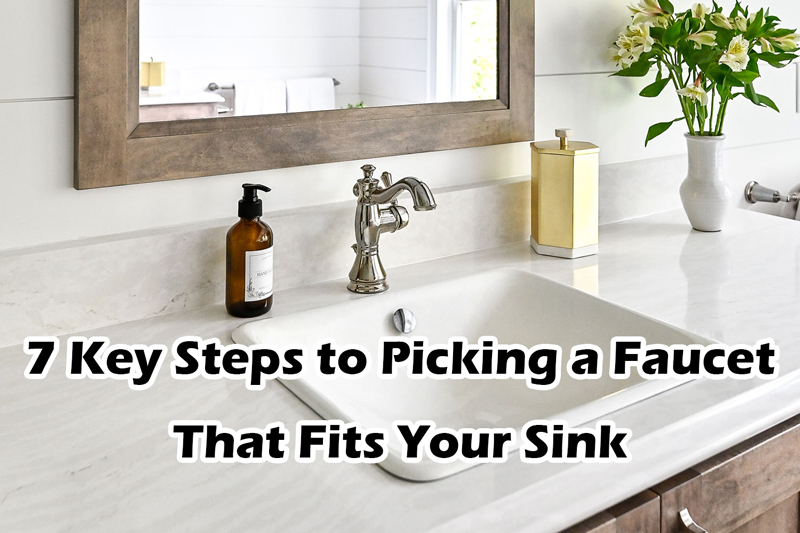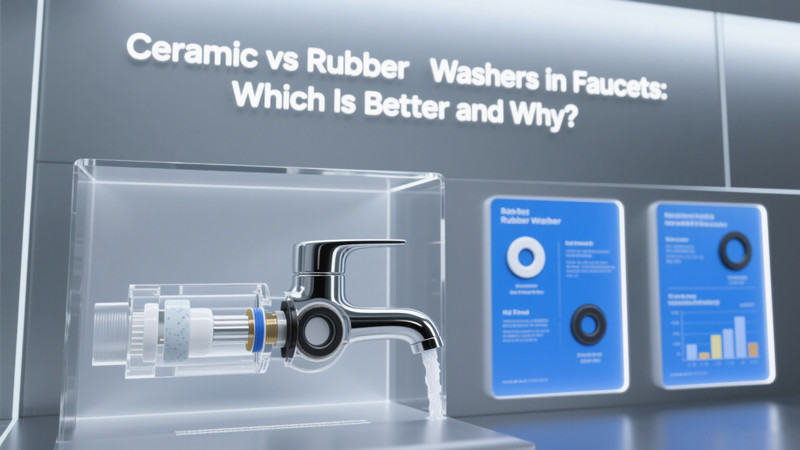
Choosing a faucet that fits your sink isn’t just about finding the right style; it’s also about compatibility, function, and practicality. Whether you’re installing a faucet in a new sink or replacing an old one, here’s everything you need to know to pick the perfect fit.
7 Key Steps to Picking a Faucet That Fits Your Sink
1. Check Your Sink’s Mounting Holes
One of the first things to consider is the number of mounting holes your sink has. Many sinks come pre-drilled with one to four holes for faucet installation, and the faucet you choose must match this setup. Here’s how these configurations work:
- Single-hole faucets: If your sink has only one hole, you’ll need a single-hole faucet. These faucets are streamlined and often come with a single handle for controlling both temperature and water flow, making them perfect for modern, minimalist designs.
- Three-hole faucets: Many sinks are drilled with three holes, often for a traditional setup. If this is the case, you can choose between two-handled faucets or even three-piece faucets with a separate hot, cold, and spout setup. Some single-hole faucets come with an additional deck plate to cover the extra holes if you prefer a single-handle style.
- Four-hole faucets: Sinks with four holes allow for extra features. You might have a traditional three-hole faucet setup plus an additional hole for accessories like a soap dispenser, sprayer, or filtered water spout.
If you’re unsure about the holes, remove the old faucet and measure the holes on your sink to ensure compatibility with a new faucet.
2. Measure Your Sink’s Faucet Space
Not all faucets are the same height and reach, so it’s important to measure the available space in your sink area to avoid issues. Here’s what to look for:
- Height: Measure the distance from the countertop to any cabinets or shelves above. Taller faucets, especially those with a high arc, may not fit under low-hanging cabinets. For small bathrooms, a lower-profile faucet is generally a better choice to avoid crowding the space.
- Spout reach: Spout reach refers to how far the faucet extends over the sink. A spout that’s too short may not provide full coverage, while one that’s too long could create splashes on the countertop. Measure the distance from the center of your sink to the front edge to get an idea of what spout reach is ideal for your sink.
3. Match the Faucet Type with the Sink
Certain faucets are more compatible with certain types of sinks, especially in terms of style and function. Here are a few common faucet types to consider:
- Single-handle faucets: These are very popular because they’re easy to use and install, with one handle that controls both water temperature and flow. Single-handle faucets work well with single-hole sinks and can provide a streamlined look in bathrooms and kitchens alike.
- Double-handle faucets: With separate handles for hot and cold water, double-handle faucets give you more control over the temperature. They’re perfect for three-hole sink setups and are often seen in traditional and transitional style bathrooms.
- Widespread faucets: Widespread faucets have separate hot and cold handles and spouts, which are generally spaced apart. They look elegant and are a great option if you have a three-hole sink and want a more sophisticated setup.
- Wall-mounted faucets: If you’re aiming for a modern, unique look, consider a wall-mounted faucet. These faucets are attached to the wall rather than the sink or countertop, giving your bathroom or kitchen a sleek, minimal appearance. Just make sure your sink is deep enough to handle any splashes, as wall-mounted faucets often have a longer spout reach.
4. Consider Your Water Lines and Connection Size
Before buying a faucet, check your water lines to make sure they’re compatible. Most standard faucets in the U.S. use 3/8-inch connection lines, but some older plumbing setups may use 1/2-inch lines. If your existing water lines don’t match the new faucet’s connections, adapters are often available to help make it work.
5. Decide on Faucet Handle Options
Your faucet’s handles affect both the style and functionality of the sink area. Here’s a breakdown of common handle options:
- Single-handle faucets: These are popular for their simplicity and compact design. You control both temperature and flow with one handle, which is great for small spaces and modern bathrooms.
- Double-handle faucets: Ideal for classic and traditional settings, double-handle faucets allow for precise control over hot and cold water. These faucets usually require three-hole sinks.
- Touchless faucets: If you’re looking for convenience and hygiene, touchless faucets are a smart choice. They use sensors to turn the water on and off, and they’re especially popular in kitchens. Just make sure your sink area has access to an electrical outlet or battery power for the sensor.
6. Choose a Faucet Style That Complements Your Sink
While functionality is crucial, you’ll also want to pick a faucet style that complements the look of your sink and overall space. Here are a few style tips:
- Modern faucets tend to be sleek, with simple lines and single handles, while traditional faucets often feature curved designs and multiple handles. A modern sink looks great with a minimalist faucet, while a farmhouse or vintage sink may look better with a more decorative, classic faucet style.
- Finish options like chrome, stainless steel, matte black, and brushed nickel can help tie together your faucet with the other fixtures in the bathroom or kitchen. For example, if you have a farmhouse kitchen sink, a brushed nickel or oil-rubbed bronze faucet might enhance the rustic look. On the other hand, a matte black faucet can give a contemporary edge to a bathroom with white or neutral tones.
7. Check the Installation Process
Finally, consider the installation process of the faucet you’re buying. Some faucets are designed for DIY installation, while others may require professional help. If you’re comfortable with DIY projects, look for faucets that come with detailed instructions and the necessary hardware. If the faucet installation seems complex or you’re not familiar with plumbing, it’s best to hire a professional to avoid any issues.
Conclusion
Finding the right faucet for your sink involves a combination of style, functionality, and compatibility. Start by checking your sink’s mounting holes, measuring the available space, and understanding your water line connections. Then, choose a faucet type and style that complements your sink, and don’t forget to consider how easy it will be to install.
With these tips, you’ll be well on your way to choosing a faucet that not only fits your sink but also elevates the entire look and function of your bathroom or kitchen. A well-chosen faucet is more than just a practical item; it’s an opportunity to add style and character to one of the most frequently used spaces in your home!
 WOWOW Faucets
WOWOW Faucets




